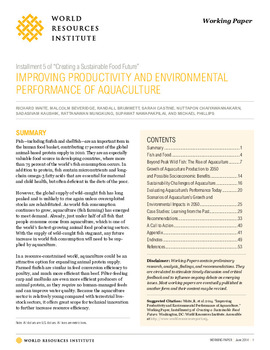Improving productivity and environmental performance of aquaculture

Citation
Waite, R. et al. (2014). Improving productivity and environmental performance of aquaculture. Working Paper, Installment 5 of Creating a Sustainable Food Future. Washington, DC: World Resources Institute
Fish--including finfish and shellfish--are an important item in the human food basket, contributing 17 percent of the global animal-based protein supply in 2010. They are an especially valuable food source in developing countries, where more than 75 percent of the world's fish consumption occurs. In addition to protein, fish contain micronutrients and longchain omega-3 fatty acids that are essential for maternal and child health, but often deficient in the diets of the poor. However, the global supply of wild-caught fish has long peaked and is unlikely to rise again unless overexploited stocks are rehabilitated. As world fish consumption continues to grow, aquaculture (fish farming) has emerged to meet demand. Already, just under half of all fish that people consume come from aquaculture, which is one of the world's fastest-growing animal food producing sectors. With the supply of wild-caught fish stagnant, any future increase in world fish consumption will need to be supplied by aquaculture. This working paper explores the potential role of aquaculture in meeting global fish demand in 2050, finding that aquaculture production will need to more than double by midcentury. The authors examine scenarios of aquaculture's growth and environmental impacts in 2050 and close with a series of recommendations for how to sustainably grow aquaculture production.
Permalink
Date Available
Type
Publisher
Copyright
CC BY 4.0
Research Themes